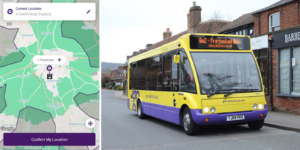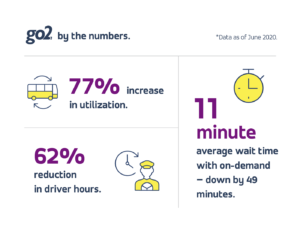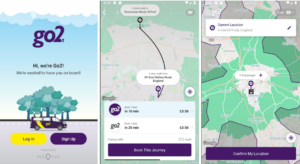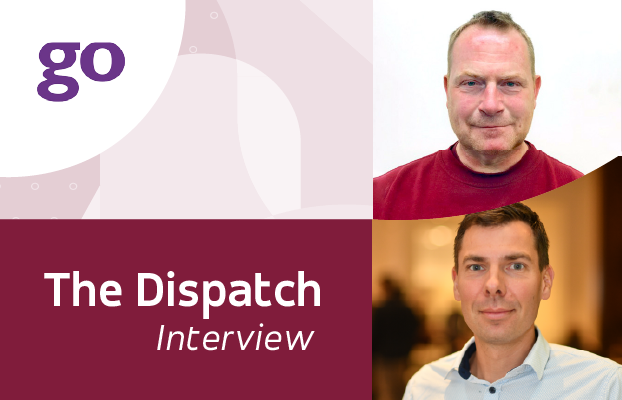Don't miss another podcast. Sign up here.
It took a global pandemic for leaders in the United Kingdom to realize that when it comes to operating public transportation, sometimes less is more. Go-Coach, the local transport operator in Kent, previously oversaw a fixed-line bus network in the town of Sevenoaks. Many of its bus routes ran once an hour, with specific routes stopping in some rural areas only once per week. In an effort to serve more residents with greater frequency, leaders at Go-Coach were preparing to add a demand-responsive transport (DRT) service to its network, a move positioned as a game changer for the community.
But as the COVID-19 crisis hit, the mobility needs in the community quickly changed. With most residents staying home, Go-Coach experienced a 90% drop in ridership. This presented two problems: they couldn’t completely cut service because essential employees in Sevenoaks still needed a safe and reliable way to get to work, and Go-Coach needed to make swift changes to reduce costs.

Austin Blackburn, Go-Coach Managing Director, explained that they saw this unfortunate time for their community as an opportunity to rethink public transport. That meant going back to the drawing board and launching their upcoming DRT service two months ahead of schedule, replacing the smaller vehicles from their initial plan with their normal fixed-line buses that allowed for social distancing and helped riders feel safe traveling to work.
Within just two weeks of hatching the idea, Go-Coach was able to launch a new service called Go2 with a zone that included four hospitals, temporarily replacing all their fixed-routes with a more cost-effective on-demand service.

Serving more riders by driving half as much.
Go2 proved to be an immediate hit, both with riders and Go-Coach. In just one month of service, Go2 began servicing much more efficient rides than the legacy service. With the original fixed-line bus route, a typical bus carried just 1.3 riders per hour. But with the shift to a demand-responsive service, Go2 was able to use fewer buses to service those rides – each bus now carrying over 2 riders per hour, with fewer miles driven. Overall, that meant a 77% increase in utilisation in just one month.
Before the new service launched, infrequent bus times and more restrictive fixed-routes meant Go-Coach wasn’t able to reach all community members, especially those in rural areas. “The services that we already operate at the moment on fixed-lines really aren’t attractive to some riders like commuters, people living in rural areas. We’re looking for a way of doing it in a better way, and also in a more economic way, because it’s quite expensive to run big buses carrying fewer people in the evenings and the mornings,” Blackburn said.
Thanks to a demand-responsive solution, the average time a rider waits for their pickup has also decreased. Before, buses only ran every hour on the hour. With the new service, riders now wait an average of just 11 minutes. On top of that, drivers are spending less idle time on the road following fixed-routes, rather than heading directly to pickups and dropoffs, resulting in a 46% reduction in miles driven – a win for both Go-Coach and the environment. Go-Coach has seen a significant reduction in the hours drivers have had to be behind the wheel – since they don’t have to follow fixed-lines to scheduled stops without waiting for riders. The result: providing much more efficient and accessible transportation.

Blackburn says the reaction to the service has been positive. Within the first month of service, the average daily rider rating was 5 out of 5 stars. “We haven’t had one negative email or call from the public; they seem to really like it,” Blackburn says. “Before, the most frequent buses were once an hour, some run once a week. That’s obviously a huge bonus for those who need to travel around.” Riders appreciate the ease and flexibility of the updated service. “I previously had to get a train and a bus to get to work, and now my journey is much easier as I only need to book a single ride on Go2,” said Maxine Fuller.
Blackburn shared he’s not only hearing from riders; drivers like it too, especially since riders are so thrilled with the service. “It’s more positive than we thought it would be, and now every average driver ride-rating is 5/5 in the app, which is really very good.”
When riders, drivers, and operators are happy, you know you have a successful service. That’s something Go-Coach can be thankful for. “Via’s technology just works. It works for the public, it works for the operators, it works for the drivers. They all really, really like it.”

How transport will change in Sevenoaks after COVID-19.
Just because riders like the service now hasn’t stopped Go-Coach from thinking about ways they can continue to adapt and make it even better in the future. As communities around the world are also thinking about what life after lockdown looks like, places like Kent will have to adapt from pandemic-focused services to growing safety concerns and new ridership needs.
Blackburn says they have a plan (and an app) for that. Having a small, dedicated team has allowed them to be agile and adaptable when they needed it most. And they’ve devised a three phase plan to digitize their network with a combination of on-demand and fixed-route buses:
- Phase one: Demand-responsive buses. Using on-demand technology within their fleet of large buses has meant that Go-Coach can accommodate physical distancing measures more easily to ensure that riders feel safe and comfortable with public transport.
- Phase two: Expand the service area and operate additional on-demand buses, some with fixed-routes. As cities and businesses start opening up, Go-Coach will scale up their on-demand service, bringing back some fixed-line buses when passenger volumes along the busiest routes pick up. Sevenoaks envisions a future in which fixed-line complements on-demand, possibly both in one app, all housed together for easier operations and an improved rider and driver experience.
- Phase three: Reintegrate smaller on-demand vehicles, and fixed-line buses. Go-Coach’s third phase returns to their original, pre-COVID plan. It introduces smaller vehicles as originally conceived in order to accommodate both on-demand rides and fixed-line buses. Giving a full range of public and private offerings to community members, phase three of Go-Coach would increase access to goods and services across Sevenoaks.
Before COVID, towns like Sevenoaks were only beginning to plan for on-demand and tech-enabled transit among their public transportation offerings. The coronavirus pandemic may have pushed Go-Coach to make a change in their initial plans, but it also sped up the implementation of a more convenient, accessible, and cost-effective transit option for their community in a time of dire need.



